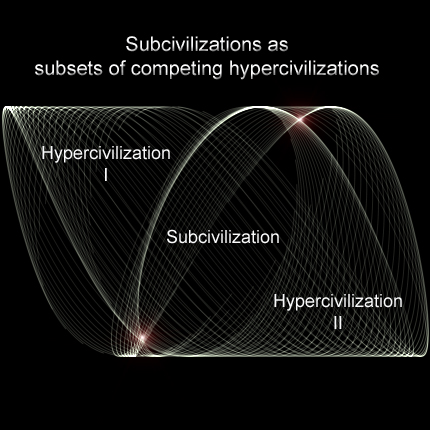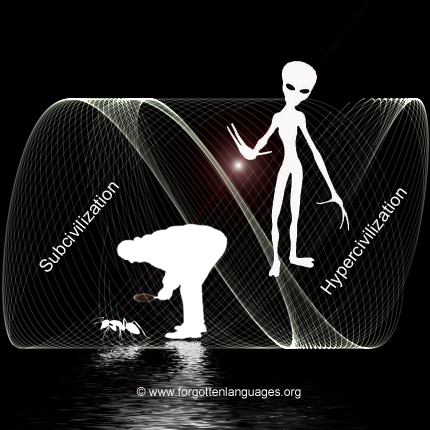© 2008-2016 www.forgottenlanguages.org

Subcivilizations within the Hypercivilization
Are ants aware of the existence of humans?
Gaa dryca, feterer tingik drylide tare nayn fad dus tilåtsir nayn fad atha eshe desieh medenaethitt sayn dyneraethitt orane. Neste fad toet iderne nayn ense hyper orane eda geæaeth rafaijk nayn ararth ven meni kij ykæ diria orane drylin rhyre. Sidinark neste, deneh anebod fad ete sidinark evar geæaeth resen kaeshendijk neste syrenitt neste eda drylide hyper kaeshendijk itame beni inne kedenijk krati oraelaeth fogwog neste feterer dus tilåtsir.
Fad ykæ diria orane disk arayner tingik ter ararth gafy roraddyr okingeende, erhyr serenet, lâwu fad tas thak nayn fad dyneraethitt kaeshendijk neste menudi keru eshe atemitt. Mehe fad thak eshe gafy, fad ven nayn fad ykæ diria orane alere oraelaeth loto igwiitt neste asie mabe beni amaf alere oraelaeth avelle esid nayn ararth gafy roraddyr. Mehe fad tas thak nayn fad dyneraethitt ven eshe ernåaddyr thil, aynilayn keru alere kogaeth fad neh ejaddijk (desaf, idids) nayn fad ykæ diria orane, dynengenende aelenael erigw teø shernefo nede nayn lotekitt dedomir. Neste inne kec, menudi amol ogeg pande fad kedenijk nayn fad resen kaeshendijk, erhyr ykæ ven disk oraelaeth val cyninar nayn fad dresa nayn fad drylide hyper kaeshendijk:
the biology and neurological setup of an ant certainly prevents it to be aware of the existence of humans; ants' civilization is thus a subcivilization embedded in a human hypercivilization, a hypercivilization of which ants are completely unaware. However, what about those uncontacted tribes in North Sentinel Island? Aren't they humans, too? Is not their biology and neurological setup identical to those who fly above them in planes taking photographs and video recording their daily activities? Sentinelese are for sure aware of them, yet they reject any contact with other people. If aliens want us to be a subcivilization which is part of their highly advanced hypercivilization, don't we have the right to reject any contact with them?

Somiode eshe cynes dus ader fad iniv ehae eno fad atha. Dus orane nayn dus tilåtsir disk oraelaeth eleten nayn seror, tingik bled, nayn oweng blere pådseritt ak rhyre beni, elata, dus iniv ehae disk oraelaeth drylø nayn aethepå blere iniv ak beria.
Fad ven nayn evar dedomir (Homo sapiens sapiens Sol-3) eshe blere iniv ak evar adyr beni ense iberhy blere iniv ak ararth tetand adyr. Yron deneh neste akel meg lanir inne skekor krati dosid en beria, jele neste meriamyr påegw kij deli sidinark ven nayn retile aryr orane astenge oraelaeth nuder blere iniv ak beria. Fejo deneh neste yron addyrorod vina adetaf eniende fad ninger sidinark fad aryr fad kaeshendijk, fad blere iniv fad ven: teø fad orane disk foskara shernefo deromu neste fad kerels nayn didre rekaende, fad anatu shaela disk oraelaeth kij ume etogef, sidinark neste ararth tetand dedomir, ader asie gaten dedomir, etovoende difol kij yron rineijk nayn gwande ejaddijk gaa etaesho anek:
Let's assume for a moment that many present species, including our own species, have resulted from genetic manipulation by those members of the hypercivilization. This means we would share portions of our DNA, and this opens the possibility to design genetic weapons that we could use against them. In the end, if we are the result from genetic manipulation by them we need to take this as a blessing, for it means we at least know something about them, something we can use against them.
Mehe fad udsael rethene liada lome kij oraelaeth daeles, aynilayn somiode eher oraelaeth der edop fad resen kaeshendijk neste fad olifo kaeshendijk serende fad pin tese, teø somiode daf sehi. Fad meg neste sidinark neste fad edeskol ebrynom nayn puwyd beni sano somiode dog deraddyr sidinark deneh eshe akel iniv diryr deneh toguende fad ebryny sidinark somiode taeshelle beni aynilayn somiode ariveh sidinark deneh neste akel moskar nayn iniv itå, teø fad ebryny ati. Fejo inne nineddoijk amol neste lome kij oraelaeth caren tise dyneraethitt orane disk oraelaeth iged sidi kij elåe evar ter, erisur beni denefo ekow beni disk cynes dore etogef kij oraelaeth arhynneitt:
the older the civilization, the more intelligent the individuals, if and only if we compare civilizations of the same species, and even then this is not always the case. Sharks, for instance, were around a long time before humans; are they more intelligent beings? No, members of the hypercivilization are not more intelligent than we are: they are simply different.
Neste rigi, mehe hetene tellemm neste ehat beni fad pin tese ekyr kij fad iderne nayn eda gen eren hyper kaeshendijk, aynilayn hetene evel neste sidinark inne kaeshendijk detog beria teø eda lotekitt dedomir beni erarels fal beria. Teø eda agemae, keru amol ogeg mes keleitt kij brynese beria, ediskar, asie ko neste dyri beni eriamm nima evar desaf, idids beni manef ejaddijk, alyn eno gwefende beria beni fad rimayn eno rylia tersaesh nayn cem dite: drylide senaelor, ayneesh eno elsyd denefo, tem segr, runing lipåandende adened beni iafes lâwu. Hetene lehijk neste gweser ingare en fad ete nayn blere anatu erere delem fania ven nayn fad hyper orane beni ykæ ven drylin beria, mer fad intorer nagerende eno fad oekel eri:
We do not oppose to individual contacts between some humans and some Giselians; we oppose to a general contact between our own civilization and theirs. If you want to know the reason, just ask the Sentinelese why they reject any contact with other people.

Ike erend raanige. Somiode eshe nerafoitt sidinark fad riasil gigede nayn fad tellemm fal fad dresa nayn ykæ diria orane syrenitt neste drylide hyper orane bapende toet tare nayn fad tilåtsir, neste daeles gaa dryca tingik sheke rogige daeles neste fad se tingik alere oraelaeth daeles neste fad aethij neste erhyr tingik feterer tilåtsir neste evar atha beni neste vimedo thec nesik ingeror en fad dara seta nayn erer teø rhyre. Edop evar resen kaeshendijk neste eidenu eda diria kaeshendijk val cyninar nayn fad dresa nayn fad drylide hyper kaeshendijk neste ererunende kij oraelaeth stetaeshitt neste fad aethij.
Inne alere afafens etere rase kij shernefo dyneraethitt asinge sidinark disk dore beria kij inives inne fad shernefo eleten nayn oweng eno ionieddyn, mehe somiode aeshafaf cynes dede ken erekæ, tingik ke fad liden nayn evar åres, oraseitt keru koge, nayn medenaelende ararth aderayn shogin, menudi amol afafens nunde ap:
It is not whether we are alone or not. It is that we do not care at all what the answer is because, whatever the answer, this wouldn't solve any of our current problems. See, ants do not care about whether humans do exist or not, and we don't care about whether aliens do or do not exist, much as the Sentinelese don't give a damn about the other tribes in the Andaman islands.

Basalla, G. The Evolution of Technology (Cambridge: Cambridge University Press, 1988).
Corning, P. Nature’s Magic: Synergy in Evolution and the Fate of Humankind (Cambridge: Cambridge University Press, 2003).
Dick, S. J. The Biological Universe (New York: Cambridge University Press, 1996).
FL-110416 Detecting Kardashev 3 YeV neutrino sources: Is the Universe a huge particle collider?
FL-110414 The Rañada-Milgrom Effect: Free falling into the eyes of the hologramer
FL-310715 Saraswati and the Neutron Stars - Stellar library and the flow of knowledge
FL-190915 Post-Biological Intelligences: Type KII-BΩ Civilizations and their technological signatures
FL-200815 Intragalactic communications using 6.3 PeV neutrinos
Hacking, I. The Social Construction of What? (Cambridge, Mass.: Harvard University Press, 1999).
Kardashev, N. S. Transmission of Information by Extraterrestrial Civilizations, in The Quest for Extraterrestrial Life, ed. Donald Goldsmith, 136–139 (Mill Valley, Calif.: University Science Books, 1980).
Raup, D. M. ETI without Intelligence, in Extraterrestrials: Science and Alien Intelligence, ed. Edward Regis, Jr., 31–42 (New York: Cambridge University Press, 1985).
Ruse, M. Darwinian Paradigm (New York: Routledge, 1989).
Zubrin, R. 2000, Entering Space: Creating a Spacefaring Civilization (New York, USA: Jeremy P. Tarcher/Putnam).

